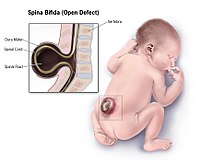
Photo from wikipedia
» Globally, the prevalence of myelomeningocele, the most common subtype of spina bifida, is 0.2 to 6.5 per 1,000 live births. In the U.S., adults account for >67% of the… Click to show full abstract
» Globally, the prevalence of myelomeningocele, the most common subtype of spina bifida, is 0.2 to 6.5 per 1,000 live births. In the U.S., adults account for >67% of the overall population with spina bifida.» With an estimated prevalence of up to 50%, scoliosis is one of the most common and severe orthopaedic conditions in patients with myelomeningocele.» The variable effects that scoliosis can have on an individual, the comorbidities associated with progressive scoliosis, and the risks associated with spine surgery call for a strong partnership and care coordination between medical and surgical teams to deliver a patient-centered approach.» A coordinated, structured, planned, and incremental team approach can help individuals achieve the overall goals of functionality and independence, as well as successful transition to adulthood.» Teams should consider a patient’s social determinants of health (e.g., poverty or language barriers) and the effect of scoliosis on quality of life before proceeding with spinal deformity correction.
Journal Title: JBJS Reviews
Year Published: 2022
Link to full text (if available)
Share on Social Media: Sign Up to like & get
recommendations!